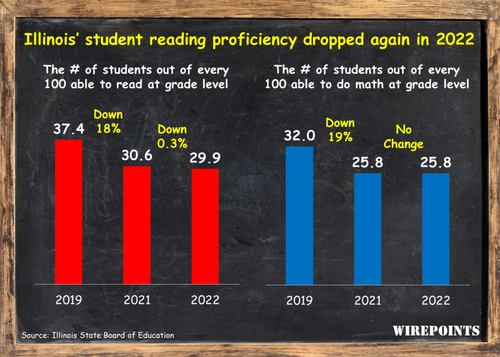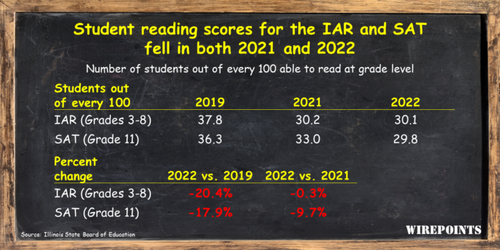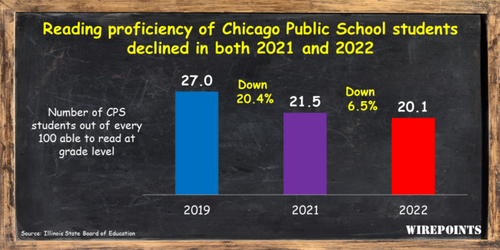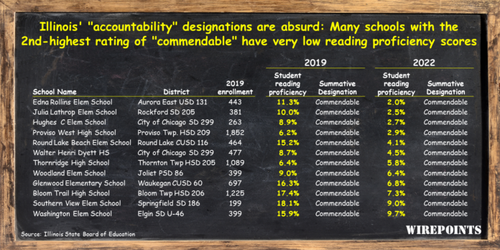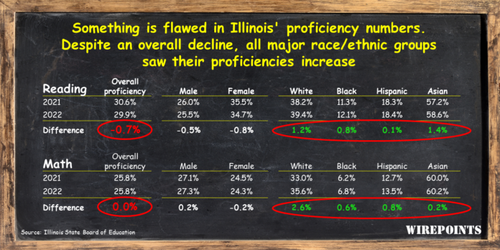6 Facts That Gov. Pritzker Doesn’t Want You To Know About Illinois’ 2022 Report Card
Authored by Ted Dabrowski and John Klingner via Wirepoints.org,
Gov. Pritzker presented a very positive outlook last week when he and the Illinois State Board of Education released the state’s 2022 Illinois Report Card. The results show “great promise” Pritzker said, and he was “proud to see that our children have a bright future.”
But at Wirepoints we’ve analyzed the data and there’s little to cheer – not if overall reading and math proficiencies are anything to go by. The reality is Illinois needs an honest look at just how poorly the state has done with what matters most in education: ensuring Illinois’ students can read and do math at a level that ensures their success in the real world.
The fact is statewide student reading proficiency dropped again in 2022. The number of students reading at grade level declined to 29.9 for every 100 students in 2022, compared to 30.6 students for every 100 the previous year.
Importantly, the 2022 declines statewide are on top of the far larger proficiency losses Illinois students suffered in 2021 vs pre-Covid 2019. Wirepoints recently reported on those large losses, where drops in proficiency in reading and math neared 20 percent.
The losses were widespread compared to 2021, with more than 40 percent of the state’s 850 school districts experiencing a drop in reading proficiency. Chicago Public Schools was one of those districts, with only 20 of every 100 students able to read at grade level in 2022.
The poor findings by Wirepoints stand in stark contrast to the Pritzker administration’s attempts to spin the 2022 education data positively. Rather than soberly address the state’s low proficiency levels, especially for minorities and many large-city school districts, the governor deflected, calling the state’s “highest graduation rate in a decade,” the rapid “pace of student growth,” the hiring of 2,500 teachers and the state’s new “Equity Journey Continuum” great achievements.
Those claims ignore the reality on the ground. Even before Covid, Illinois’ math and reading results were dismal. They are far lower today.
Here are the facts Gov. Pritzker and the Illinois State Board of Education didn’t tell you about the 2022 Report Card:
1. Reading proficiency actually dropped in 2022.
Despite Gov. Pritzker and ISBE’s talk of “growth” and “improvement,” the reality is reading proficiency shrank in 2022 at both the elementary and high school levels.
The number of elementary school students reading at grade level fell to just 30.1 out of every 100 students in 2022. That’s compared to 30.2 students in 2021 and 37.8 students in 2019.
The decline for high school students was similar. The number of reading-proficient students fell to just 29.8 for every 100 students. That’s compared to 33 students in 2021 and 36.3 students in 2019.
What’s most concerning is the drop in reading proficiency among third-grade students. The ability to read in third grade is critical because if children can’t read by then, they’ll have real trouble learning science, social studies and civics in later years.
Third-grade proficiency fell another 2 percent in 2022. Today, only 27.4 out of every hundred third graders can read at grade level, down from an already-dismal 36.4 in 2019.
The reading proficiency levels for minority third-grade students are even more painful. Just 11.1 out of every 100 black students statewide can read at grade level. For Hispanics, it’s only 15.9 out of every 100 Hispanic third-graders.
2. Over 350 districts saw overall reading proficiency drop in 2022, including Chicago
In all, 354 districts saw their share of students who could read at grade level drop in 2022.
Chicago Public Schools was among them. Reading proficiency in CPS fell another 6.5 percent in 2022. Today, only 20 out of every hundred Chicago students can read at grade level, down from just 27 in 2019.
Broken down for the district’s minorities, just 11.2 out of every 100 black students in Chicago can read at grade level. For Hispanics, it’s just 16.9 out of every 100 Hispanic students.
Regarding math, Another 246 districts saw their student proficiencies drop again in 2022.
3. A “record high” graduation rate disguises the fact that most high schoolers can’t read at grade level.
Pritzker and ISBE’s proclaimed “record high” graduation rate means nothing when you look at high schoolers’ ability to read. In 2022, 87.3 percent of high schoolers graduated statewide, but only 29.8 percent of those who took the SAT were reading at grade level.
The numbers are even more distressing for Illinois’ minorities. Nearly 79 percent of black students graduated even though only 9.4 of every 100 were reading proficient on the SAT. And Hispanics had a 85 percent graduation rate, even though only 15.9 out of every 100 could read at grade level. Results for math are even worse.
There’s little reason to celebrate graduation rates when all it means is tens of thousands of Illinois children being pushed out of the education system while neither college nor career ready.
4. Over 86 percent of Illinois schools are labeled “Exemplary or “Commendable” despite the collapse in student proficiency.
Illinois’ “accountability” standards remain broken in 2022 and that includes the metric for school performance. Schools are given one of four designations by ISBE: exemplary, commendable, targeted and comprehensive.
As seen in the graphic below, 76 percent of Illinois schools were given the 2nd-highest rating of “commendable” despite the dramatically lower results in 2022.
That’s because a school’s “summative designation” is based not just on proficiency but “on multiple measures of school performance, including student growth for elementary and middle schools and graduation rate for high schools.” In other words, schools are graded on a curve.
That leads to absurd results where schools with single-digit reading proficiency scores are rated “commendable” by ISBE.
Take the Edna Rollins Elementary in Aurora East, for example. The school was rated “commendable” in 2022 despite the fact that only 2 percent of students at the entire school could read at grade level. Or consider Thornridge High of Thornton Township 205. The school also received a “commendable” rating despite just 5.8 percent of students there being reading proficient.
The examples shown above are far from alone. There are more than 700 Illinois schools rated “commendable” where less than 20 percent of all students are reading proficient. That’s incredibly misleading for any parent looking for information about the quality of their child’s school.
5. Illinois still lacks accountability for teachers: 97 percent were rated “excellent or proficient” in 2022.
Official teacher evaluations are also entirely out-of-sync with student outcomes. Despite just 29.9 percent of Illinois students being able to read at grade level in 2022, 97.2 percent of teachers were rated “excellent or proficient” that year.
That’s the same rating for teachers as in 2019 when student reading scores were almost 20 percent higher.
In fact, of the 607 districts that performed teacher evaluations in 2022, 362 of them – more than half – declared every single one of their teachers “excellent or proficient.”
6. ISBE’s proficiency and growth numbers don’t square up.
Two things we haven’t been able to square up. The first is related to Gov. Pritzker’s comments on student growth, that “every single demographic group in Illinois experienced accelerated growth in both English Language Arts and math, outpacing pre-pandemic levels.” The administration’s emphasis on “growth,” in light of the state’s worsening outcomes, should be covered in a separate piece.
Second, we found problems with ISBE’s overall proficiency numbers compared to their racial/ethnic breakdowns. You can see the discrepancy in the data below, taken directly from the 2021 and 2022 Report Card data sets.
Despite an overall 0.7 percentage point decline in reading proficiency in 2022, all major racial demographics – whites, blacks, Hispanics and Asians (which comprise 96 percent of Illinois’ student population) – show proficiency increases. On its face, that’s mathematically impossible. Illinois’ statewide math proficiency data has the same issue.
Wirepoints contacted ISBE and asked them for clarification on the data, but as of this writing we have not received a response.
Conclusion
The results above expose the blatant hypocrisy of Illinois’ education system.
Illinois children can’t read and yet they’re graduating at record levels.
Illinois children can’t read and yet a vast majority of schools are labeled “exemplary” or “commendable.”
Illinois children can’t read and yet almost every single teacher in the state is evaluated as excellent or proficient.
And when it’s time to talk about results, there’s no honesty from our education system’s leaders. Illinois politicians and the teachers unions shouldn’t have monopoly control over our childrens’ education.
The current system is unfixable and poll after poll show parents want more choices outside of the status quo. It’s time we give it to them.
Tyler Durden
Tue, 11/01/2022 – 16:45
via ZeroHedge News https://ift.tt/xaAtJj6 Tyler Durden
